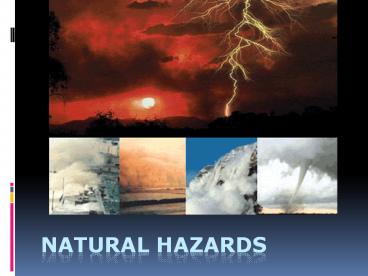Natural Hazards - PowerPoint PPT Presentation
Title:
Natural Hazards
Description:
Natural Hazards? A natural disaster (physical event) Volcanic eruption Earthquake Land Human activity Ex: coastal settlement of populations Basically .. – PowerPoint PPT presentation
Number of Views:506
Avg rating:3.0/5.0
Title: Natural Hazards
1
Natural Hazards
2
Natural Hazards?
- A natural disaster (physical event)
- Volcanic eruption
- Earthquake
- Landslide
- Human activity
- Ex coastal settlement of populations
3
Basically..
- A natural hazard is
- a naturally occurring
- event/phenomenon
- that has an effect on
- people
4
Terms to Know
- Hazard - a threat (natural or human) that has the
potential to cause loss of life, injury,
socio-economic disruption or environmental
degradation.
5
Terms to Know
- Disaster - a major hazard that causes widespread
disruption with significant demographic, economic
and environmental loss. - The affected community needs outside help.
6
Vulnerability
- Vulnerability susceptibility to injury or
attack - Human vulnerability leads to financial,
structural, and human losses. - Natural hazards only occur in inhabited areas
- A natural disaster in an uninhabited area has
little tangible impact on people - Natural hazards are increasing because of
- Population growth (more people)
- Urbanization (lots of people in small spaces)
- Alteration of the natural environment (manmade
islands)
7
Terms to Know
- Risk - the probability of a hazard event causing
harmful consequences. - Expected losses, death injury etc.
8
Hazards Human Costs
- Every year natural disasters leave
- 4,000,000 homeless
- 46,000 injured
- 5520 dead
- These figures do not include the recent tsunami
in Asia (273,000) and Hurricane Katrina (1000) - Source The International Red Cross
9
Natural Disaster Quotes
- Mr. Speaker, from hurricanes and floods in Latin
America to earthquakes in Asia, natural disasters
are increasingly becoming a regular feature of
life for large numbers of people around the
globe. Earl Blumenauer
10
Quote to Elaborate
- a world full of competing emergencies and
disasters, it really helps if there is an
international locomotive that can help us bring
attention - help us bring resources. Jan Egeland
- Did you know that the word "tsunami," which is
now being used worldwide, is a Japanese word?
This is indicative of the extent to which Japan
has been subject to frequent tsunami disasters in
the past. Junichiro Koizumi
11
Positive Effects
- natural disasters have beneficial ecological
consequences. - rejuvenation of a coniferous forest months and/or
years after fires - recharging of groundwater stocks after a flood).
- benefits tend to become apparent months or years
after an extreme event
12
Methods of Classification
- Calculating human costs
- Impact measured by
- loss of life (total deaths)
- number of injuries
- damage to property (replacement costs)
13
Methods of Classification
- Strength/size/intensity of event
- Hurricane system
- Tropical depression, tropical storm, category 1-5
- Tornado scale
- Force 1-5
- Richter scale (seismic events)
- Scale of 1-9, with 9 being cataclysmic, worldwide
event - Epidemic, pandemic
14
Methods of Classification
- Regional occurrence
- Hurricane (Atlantic)
- Typhoon (Pacific rim)
- Monsoon (Asia, Africa)
- Frequency of occurrence
- Annually?
- Centenially?
15
Disaster Categories
- We classify natural disasters by the chief
process or sphere in which it operates - Ex Atmosphere, biosphere, lithosphere
- This system has three categories
16
Atmospheric Hazards
- Cyclonic Storms (hurricane, typhoon, cyclone)
- Tornado (twisters, dust devils)
- Severe Storm (White Juan, Noreaster)
- Flooding (heavy rains)
- Drought (lack of rain, prolonged high pressure)
- Wildfire (wind, lightning)
- Severe Weather (hot/cold) ex ice storm
17
Biological Hazards
- Infectious Disease
- HIV, H1N1, Bubonic Plague)
- Parasitic Disease
- ringworm
- Insect Infestation
- malaria, West Nile virus
- Plant Disease
- Dutch Elm disease, blight
18
Geological Hazards
- Slide (mud, land, rock)
- Volcanic Activity
- Earthquake
- Avalanche
- Tsunami (tidal wave)
19
Comparison and Analysis
- Any one disaster can be described by analyzing
various factors that determine how great an
impact it will have on people - This system recognizes six main factors
20
Comparison and Analysis
- Frequency
- how often is the event likely to happen
- Duration
- the length of time the event lasts
- Extent
- Size of area or region affected
- Town? Continent? Region?
21
Comparison and Analysis
- Speed of onset
- sudden, without warning, over quickly?
- build slowly before a peak period
- Spatial dispersion
- area likely to be affected by a particular event
- Temporal spacing
- how hazards and disasters occur in time are they
random or do they occur within a cycle
22
Earthquakes
- Earthquakes occur along the boundaries of the
tectonic plates of the earths crust. - When these plates come in contact with each
other, the pressure builds up and an earthquake
occurs.
23
Tectonic Plates
24
Types of Earthquakes
- Convergent Boundaries - When two plates collide
together. This created the Himalayan mountains. - Subduction occurs when one oceanic plate goes
under a land plate. Created the Andes Mountains.
25
Types of Earthquakes
- Divergent - When two plates are moving apart.
26
Types of Earthquakes
- Transform Boundaries - when two plates slide past
each other. - This is occurring along the San Andreas Fault in
California.
27
Earthquakes - Human Causes
- Nuclear testing
- Building large dams
- Drilling for oil and gas
- Coal mining
28
Factors Affecting Earthquake Damage
- Strength and depth of earthquake, and number of
aftershocks. - Population density
29
Factors Affecting Earthquake Damage
- Time of Day
- Types of rock and sediments that buildings are
built on. - Secondary hazards
- Economic development
30
Factors Affecting Earthquake Damage - MEDCs vs.
LEDCs
- Type of buildings - MEDCs countries tend to have
better quality buildings and insurance than
LEDCs. - More prepared (ability to predict)
- More effective emergency services
- Funds to rebuild
- Relationships with other MEDCs































